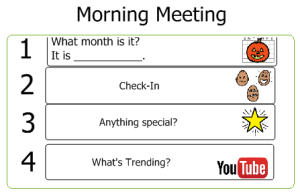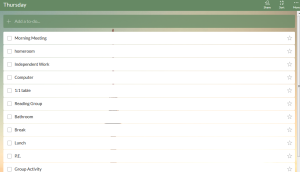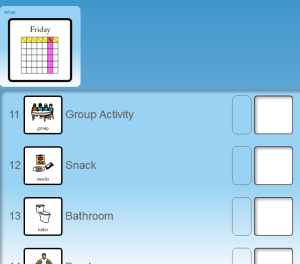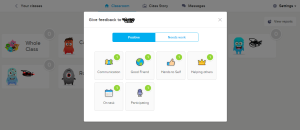New school year, new students, new goals. My classroom structure and schedule has changed this year as students and their needs change. I often stop and reflect on what I am doing: Am I maintaining the status quo because it is easier and within my comfort zone, or am I maintaining the status quo because it continues to meet student needs?
When I asked myself that question as I set up for the year, I realized that maintaining the status quo in its entirety would be entirely for the benefit of my assistants and me. I decided to make some changes in order to better meet student needs.
The primary reason that I made the changes that I will describe is that I am reacting to an influx of Augmentative and Alternative Communication (AAC) users. To meet their communication and literacy goals, I have to incorporate many more language exercises. I have tried my best to strike a balance between independence and providing adequate communication opportunities. Social group activities have also been incorporated in order to teach and practice social skills and social communication.
Another reason for the change is that my school started a Digital Learning Initiative. Each student in the building received a Chromebook and I wanted to incorporate the technology meaningfully for my students.
Morning Meeting:
In order to facilitate communication and practice conversational turn-taking, we have a morning meeting at the beginning of each school day.
We start with a turn-taking conversational exchange. I started doing a new question each day, but it quickly became obvious that we needed much more repetition. Now we are practicing the same question for an entire week. This gives us an opportunity to practice other skills that are relevant to appropriate conversation, such as facing your communication partner and using appropriate volume.
Next, each student ‘checks in.’ We are currently using a version of the Zones of Regulation by Leah Kuypers. Each student and staff member ‘checks in’ by describing how they are feeling and what “zone” they are in. Staff members model that we are not always in the “green zone” and that is A-OK by placing themselves in other zones and describing why they are feeling that way.
After we check in, we discuss any special activities that are happening that day. These can include students who are going to an off-campus job, community trips, holidays, student or staff special family events, etc. We usually have at least 3-4 ‘special’ things happening on a daily basis. Students are encouraged to share their own news using their devices through sentence starters.
Schedules:
Schedules look a lot different this year. All students are currently using a checklist-style homeroom schedule to navigate their homeroom activities. Homeroom activities include Chromebook tasks such as typing personal information into Google Forms or spending time on a website working on academic skills.
Most students access their daily activity schedule on their Chromebook. Some students type their own schedule using the application Wunderlist. Non-readers use the extension Read & Write by Google to read the next activity to them.
Other students access their schedules on GoVizzle.com. The idea of this website is great, but there are some glitches on the Chromebook. If the student closes the lid or the Chromebook goes to ‘sleep,’ then the student needs to log in all over again the schedule starts all the way back at the top. That being said, it is still the best web-based picture scheduler that I have found up to this point. Students are able to manipulate it independently when it is working well!
Off-Campus Jobs
In previous years, I have added off-campus jobs on to students’ daily schedules. This year, I left them off and instead I am discussing them during the ‘anything special’ portion of Homeroom. I am also assigning a time to those activities. This way, students practice being mindful of the actual time on the clock (or period in the school day) rather than simply following the sequence of activities on their schedule. This also gives me more freedom throughout the day to let one activity go long or cut another one short without it throwing off the schedule of students who have several time-dependent activities.
It also gives students practice with leaving activities in the middle when necessary. Some students with autism find it very difficult to disengage from something they are working on without completing it. Unfortunately, however, this is a fact of life! Practicing this every once in a while will help the student cope with these unavoidable schedule changes.
Afternoon Meeting
At the end of the day, we come together again for our afternoon meeting. Students complete the Daily Buzz sheet from the core materials on the Unique Learning System. This sheet includes cloze sentences for what the student ate for lunch, jobs the student accomplished, and how the day was overall. It also gives students the opportunity to use describing activities to rate different parts of their day.
After the Daily Buzz sheet, we discuss how each student did using the Class Dojo. We discuss different pro-social and anti-social behaviors that we saw during the day, emphasizing the positives.
If a student has had an especially wonderful day, I offer them a treat. If the whole class has done well, then we play a favorite dance song and have a dance party!
More Communication and Social Activities!
Another change has been a major increase in communication and social group activities! We have been doing AAC scavenger hunts, playing Tic Tac Talk, practicing core words and lots more to help our AAC users develop their communication skills. I am hoping to focus on these activities in another post. If you want to check out some activities right now, I recommend the blog over at http://praacticalaac.org/ . Their blog is amazing!
Like what you see? Comments, questions, or suggestions? Leave them in a comment!
Miss Part One? Check it out here.







Thank you for sharing your classroom tips and strategies. It is helpful to hear what others are doing in their classrooms.
LikeLike
You’re welcome. I’m glad you found it helpful!
LikeLike
Thank you for sharing your ideas. I am entering a new classroom this year and will have many Autistic students. I really am not sure what direction I will be taking but would like more information on your work stations. What kinds of activities do you do? And do you do a lot of repetition? I like the idea of independent practice. My kiddos will be 5th-7th grades. And I will have 2 in wheelchairs. I would just like some ideas! Thank you thank you! Karlene
LikeLike
I have spent hours searching for information on this! I am going from an elementary class for students with emotional needs to an ASD self-contained classroom in middle school. I hope to use this and anything else you have to offer as resources. Thank you SO much!!
LikeLike
Congratulations for your vocation, effort, passion for your profession and your love for children. The world needs teachers like you! thank you very much! Actually, teachers should share their experiences the same as you do. Thank you.
LikeLike